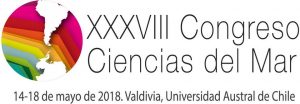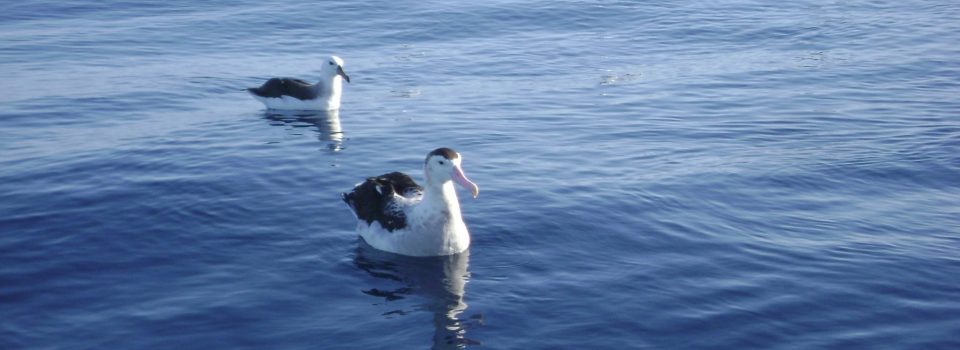IFOP presents at Marine Sciences Congress
May 9th, 2018 Universidad Austral together with Marine Sciences Chilean Society are organizing the XXXVIII Marine Sciences Congress (version 2018) which has as its slogan: Marine sciences in times of global change.
Universidad Austral together with Marine Sciences Chilean Society are organizing the XXXVIII Marine Sciences Congress (version 2018) which has as its slogan: Marine sciences in times of global change.
This event will take place between May 14th and 18th , at Villa del Río hotel in Valdivia.
The activity brings together academics, researchers and University students, Research Centers and Institutes of Chile and abroad; as well as international experts in the most emerging areas of Marine Sciences.
Read the abstractsAndrea Araya: Quantification and effects of overcapacity in pelagic reduction industry.
- Pelagic reduction industry process capacity is analyzed, in a scenario of raw material shortage. Overcapacity present in the sector can stimulate practices that do not contribute to the sustainability or recovery of fisheries (illegal and / or unreported fishing). In this context, it makes sense to pay attention to the planning and regulation not only of fishing effort and quotas; but also in the processing and production capacity of the industry.
Camilo Torres: Input-output matrix (MIP), utility for fisheries management.
- The Input Product models (Leontief, 1985) seek to consider in aggregate terms interactions that occur between different sectors of the economy. On the other hand, product input matrices describe production from demand fields and economy supply. The integration of the above, allows to decompose productive sector production in the expense related to different inputs that are necessary for productive processes, allowing estimating direct and indirect employment of the above mentioned sector, for that matter, the country fishing and aquaculture sector , making it possible to identify potential impact of management measures on this productive sector, useful information to evaluate public policies focused on fisheries management.
Camilo Torres: Fisheries Exploitation strategies Economic effects. Case study: Center-south of Chile small pelagic fish fishery.
- Bioeconomic modeling is an analytical tool that integrates biological and fisheries aspects, with social and fishery economic aspects, allowing to evaluate before, the impacts that could be generated in these management areas measures that aim to maintain or carry fishery to Maximum Sustainable Performance (MSY). Based on this, authority can determine necessary resources for mitigation and compensation actions establishment when implementing management measures.
Francisca Osorio: Spanish sardine ichthyoplankton New records (Sardinops sagax) in northern Chile (18 ° 25′-25 ° 50′)
- This work is focused on the latest positive records of Spanish sardine eggs and larvae, observed in the northern zone. Among results it was highlighted that eggs were detected during September 2015, 2016 and 2017, reaching a frequency of occurrence of 7.4% in the last year, while highest abundances were located around Mejillones (23 ° 00’S ). On the other hand, monthly samplings in the area indicated the presence of eggs and larvae of Spanish sardine in Mejillones, during the months of July, August and October of 2017, located mainly between 0-10 m deep.
Luis Figueroa: Extraction of brown algae in Exploitation of Benthonic Resources Management Areas and their implications in the conservation vision
- Extraction of Brown algae evolution in AMERB is analyzed, discussing implications that this activity can have in biodiversity conservation. Along the same lines, Universidad de Valparaíso student Tiare Padilla, with Luis Figueroa, will present the work “Population Parameters” as evaluation indicators in Lessonia trabeculata in Bentonic Resource Management and Exploitation Areas of Northern Chile state, where they give an account of status indicator of algal populations in AMERBS application and discuss its direct aid in restoration policies applicability to those areas that really need it.
Sonia Arenas (presented by Luis Figueroa): Information Quality Management System Expectations in Areas of Management and Exploitation of Bentonic Resources fishery management model (AMERB)
- They will carry out an analysis of the current AMERB system, identifying a deficient commitment of the interested parties, which ratifies the importance of developing a System that ensures information quality.
Eliana Velasco-Vinasco (presented by Luis Figueroa): Ecological Risk Assessment Implementation Fisheries Effects (ERAEF) for Management and Exploitation of Bentonic Resources Regime (AMERB)
- They present ERAEF methodology results of application in a management area located in an area of interest for its biodiversity, and the importance of using this type of tools to understand the benthic systems subject to fishing.
Fernanda Alfonso, thesis student at Universidad Andrés Bello and researcher Luis Figueroa: DPSER Model Application to identify pressures affecting ecosystemic services of Quintero bay
- They presented results concerning different pressures, both anthropic and natural, to which the Quintero Bay is subject and fishermen´s perception about them.
Ljubitza Clavijo and Luis Figueroa: Bentonic Resource Management and Exploitation Areas of Center North and Center-South of Chile community structure Inter-annual changes
- They presented obtained results from community-level monitoring and their relationship with large-scale oceanographic events such as El Niño and La Niña, discussing implications that may arise in populations of species of fishery interest.
Luis Figueroa: Association between the gastropod Iselica chilensis (Gastropoda – Pyramidellidae) and two clams of commercial importance present in an intertidal, sedimentary plain of the inland sea of Chiloé (Hualaihue-Palena)
- The presence of the gastropod in the inland sea of Chiloé is reported for the first time.
Eduardo P. Pérez E.a, Francisco J. Galleguillos Foix b: Bio-economic analysis applied to small-scale algae aquaculture: a tool for decision making.
- Small-scale algae aquaculture is currently stimulated by different regulatory and financial mechanisms. In this context, Applied Bio-Economic Approaches use helps to decide which algae cultivate and production and commercialization strategies. The study evaluated scenarios of Small Scale Aquaculture for “pelillo”, “huiro float”, “luga negra” and “chicorea de mar”. The results indicate that, of 4 analyzed species, only “pelillo” and “black spot” show profitable scenarios to develop small scale aquaculture.
Rodrigo Rojas, Hernán Padilla, Oscar Espinoza-González, Jordina Iglesias, Yessica Robles, Gastón Vidal, María Tocornal, Leonardo Guzmán: Space dynamics of FANs in the Aysén region, relationship between the presence of harmful microalgae with lipophilic and paralyzing toxins present in seafood.
- Phytoplankton in the Aysén region has seasonal and spatial patterns due to environmental regional particular geographical gradients configuration. In this sense, there are particular sectors that recurrently present high densities of harmful microalgae. We analyze harmful microalgae densities and toxins presence in seafood . Jacaf-Puyuhuapi, Moraleda and Pto. Aguirre sectors presented high densities of noxious phytoplankton with a similar geographic pattern in toxins in shellfish accumulation
Sebastián Cook: Novel ecosystems generated by small-scale aquaculture in southern Chile, implications for the maintenance and conservation of marine ecosystems intervened.
- Bivalves Small-scale aquaculture (APE) is concentrated in inland waters in Region de Los Lagos .Generated impacts depend on the volume of culture, waste and detachment of individuals. It is proposed that, under certain conditions, material that emerges from crops promotes emerging ecosystems generation, favoring local biodiversity. Evidence is presented that species richness increases under cultivation modules compared with neighboring reference sites. This case suggests that APE would promote certain groups biodiversity (e.g., mobile invertebrates) at the local level depending on crop volumes and eco-hydrological factors.
Oscar Espinoza-González, Valentina Besoaín and Pamela Carbonell: Vertical distribution of Alexandrium catenella pattern in southern Chile fjords and channels
- The Alexandrium catenella blooms are recurrent since 1994 in the Aysén region. This work evaluates vertical distribution of this microalga from oceanographic campaigns (spring and summer) in 10 stations located between Puyuhuapi fjord and the Jacaf channel and proposes as main results that the vertical distribution of A.catenella on the surface of the column of water would be associated with weak stratification, which would facilitate vertical migration of cells accumulating on the surface, where the availability of nutrients and light is optimal for growth
